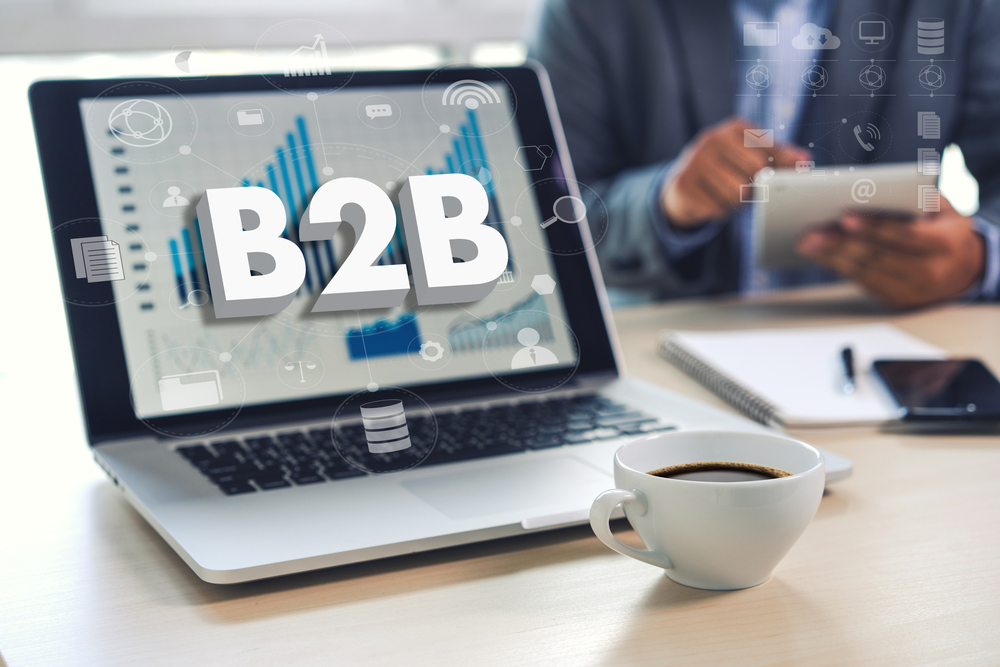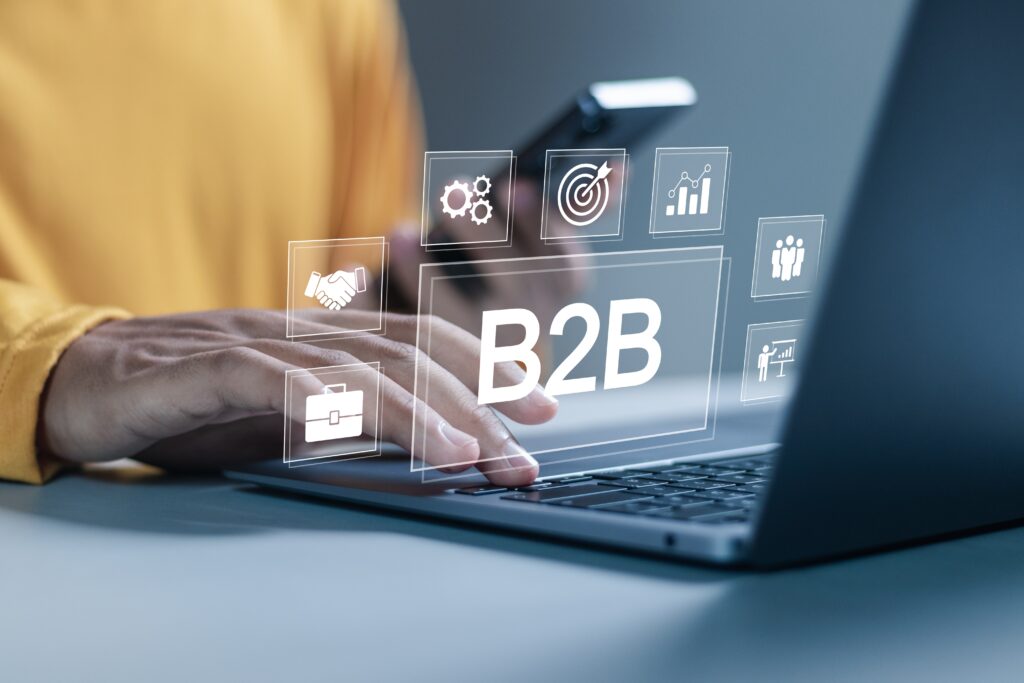Globally, the B2B market is set to reach an astonishing $20.9 trillion by the end of 2024, highlighting the massive growth potential for businesses in this space (Shivani, 2024). With over 3 million B2B businesses in the United States alone, generating trillions of dollars in revenue, the sector is both vast and highly competitive. B2B companies, which provide essential products and services to other enterprises, are crucial in ensuring the smooth operation of their clients.
The digital shift has propelled B2B eCommerce into the spotlight, with projections indicating that U.S. B2B eCommerce sales will surpass $2.3 trillion this year, presenting boundless opportunities for market share growth (Keenan, 2024).
With buyers’ habits evolving—more than half of B2B buyers now make purchases daily—it is crucial for businesses to stay relevant and adapt to these changes (Keenan, 2024). This article explores the top B2B eCommerce trends for 2024, offering insights to help businesses thrive in this rapidly changing environment.

Trend #1: Social Commerce
The popularity of virtual product demonstrations is steadily increasing in the B2B ecommerce sector. A recent survey revealed that 70% of professionals made purchases after experiencing a presentation in the metaverse or via virtual reality. Additionally, 21% expressed interest in trying virtual demonstrations despite having not yet experienced them (Keenan, 2024).
While social commerce has traditionally been associated with B2C marketing, B2B brands are increasingly leveraging this strategy. The global social commerce market is projected to reach $8.5 trillion by 2030, highlighting its growing importance (Oleksandra, n.d.). B2B companies are discovering that their target audience actively searches for products on social media platforms. In fact, Gartner reports that B2B buyers value third-party interactions 1.4 times more than direct digital supplier interactions (Keenan, 2024).
B2B buyers utilize social media in various ways throughout the purchasing process:
Choosing the right social media platforms is key to successfully implementing a social commerce strategy. It is essential to identify which platforms are most relevant to your audience and conducive to engaging with your product offerings. Experimenting with different types of posts, such as product demo videos or customer testimonials, can help determine what resonates best with your target audience.
Once you’re ready to embrace social commerce tools, adding product catalogs to each platform can make it easier for potential customers to browse your inventory (Oleksandra, n.d.).
Trend #2: Prioritizing Order Fulfillment and Tracking
Order fulfillment and tracking have become top priorities in B2B ecommerce. A 2023 survey revealed that nearly 66% of B2B buyers find these aspects increasingly challenging (Keenan, 2024). Despite these difficulties, customer expectations for faster delivery times are rising: 41% of global shoppers expect to receive their online purchases within 24 hours, and 24% want their orders delivered in less than 2 hours. This demand for speed is pushing B2B companies to optimize for quicker delivery.
Leveraging third-party logistics (3PL) providers can help B2B brands meet these expectations by streamlining the fulfillment process and reducing costs. Additionally, early planning for peak seasons and diversifying suppliers can mitigate supply chain disruptions.
Enhancing the user experience involves implementing self-service portals, allowing customers to interact with the company, check order statuses, and book appointments in a closed environment. Starting with a minimum viable product (MVP) and gradually adding features based on customer feedback can ensure the portal meets their needs. Automated processes for repeated orders and notifications can further enhance the user experience.

Trend #3: Marketplaces as Key Sales Channels
B2B marketplaces are becoming essential for sales, currently representing 12% of all U.S. B2B ecommerce transactions (Keenan, 2024). This growth is driven by changing buyer preferences. Five years ago, there were only 75 B2B marketplaces; now, forecasts suggest this number could increase to 750 by 2025.
The 2023 B2B Marketplace 500 Report by Digital Commerce indicates that 60% of businesses have integrated B2B marketplaces, with buyers completing around 25% of their purchases on these platforms. Both company-owned and third-party marketplaces are significant business hubs, with an 8% rise in the use of company-owned marketplaces observed last year. Furthermore, 40% of leading companies utilize third-party marketplaces, compared to just 27% of less successful firms.
Many companies either run their own marketplace or have plans to create one. Top performers often excel in sector-specific marketplaces. Globally, 88% of businesses sell through platforms like Amazon, with this figure rising to 97% in India and 93% in the U.S. Industries such as consumer goods and retail (92%) and technology, media, and telecom (90%) dominate these third-party spaces.
Regions like Brazil, India, Western Europe, and East Asia offer significant opportunities for B2B marketplaces. Early adopters in these areas can gain a competitive advantage by tailoring their strategies to each platform, offering unique products, and running targeted experiments.
Trend #4: Customers Will Embrace Self-Service
Self-service portals have become a crucial expectation for B2B buyers. In 2023, nearly all buyers preferred to manage their own buying experience, a significant increase from 87% in 2021. Vendor sales reps, previously not a top source, became the second-most preferred information source in 2023 (Keenan, 2024).
Self-service commerce streamlines the buying process and can include subscriptions, AI-assisted interactions, customer communities, help centers, and customer portals. These tools reduce the need for manual sales interventions and enhance transaction accuracy, thereby shortening sales cycles and expanding market reach.
Trend #5: Adoption of Headless Commerce
Headless commerce is gaining traction, with $1.65 billion invested in headless technologies in 2020-2021. About 74% of organizations believe that not adopting modern commerce solutions can negatively impact their business (Keenan, 2024). Headless architecture separates the front-end experience from the back-end infrastructure, allowing for full customization, faster load times, reduced IT dependency, rapid scaling, and quicker market entry.
Companies using headless setups are more likely to expand into new channels and report a higher ROI. For instance, businesses with headless architecture can make quicker storefront changes, avoiding the delays faced by those with traditional setups.
Trend #6: Omnichannel Sales
B2B businesses are increasingly adopting omnichannel sales strategies, offering products and services through various channels such as in-person, email, phone, websites, mobile apps, and web chat. Buyers now prefer an omnichannel approach regardless of their size, industry, or location (Oleksandra, n.d.).
To implement an effective omnichannel strategy, start by identifying where your target audience searches for your services. Initially, focus on two or three channels to ensure a smooth customer experience before expanding.
In 2023, 83% of buyers preferred digital commerce, and 72% were open to purchasing across multiple channels. Successful B2B companies introduce new channels and experiment to find the most effective sales avenues. Modern buyers use various digital technologies, including mobile apps and social media, to evaluate suppliers.
To stay competitive, businesses must excel in multiple channels and continuously reassess their performance. An omnichannel strategy is crucial, especially during uncertain economic times, as a poor customer experience can lead to lost sales.

Trend #7: Increasing Adoption of Mobile Apps
In 2024, more B2B ecommerce businesses will develop mobile apps, moving beyond simply replicating the B2C experience. In 2022, U.S. mobile retail ecommerce spending exceeded $387 billion, with over 70% of B2B health and beauty businesses investing in mobile apps (Keenan, 2024).
Mobile apps are no longer a novelty. Brands like Muji, Grailed, and Kenny Flowers have focused on app development, which serves not just as digital storefronts but also as tools for real-time inventory communication and customer feedback—essential in managing ongoing supply chain disruptions.
Mobile apps offer B2B businesses unique selling tools, such as push notifications, in-app ads, SMS notifications, and social channel integrations. This allows them to reach previously untapped audiences and improve customer engagement. For example, brands using NewStore’s app platform saw a significant increase in site engagement and customer lifetime value.
Much like B2C businesses, B2B companies can leverage mobile apps to gain insights into customer behavior, order history, upselling opportunities, and real-time engagement. This helps tackle inventory challenges, enhance in-store experiences, and build customer loyalty.
Trend #8: Increased Tech Adoption in B2B Organizations
Even in economic downturns, market leaders prioritize integrating advanced technology to maintain a competitive edge. Leading companies are 55% more likely to plan the adoption of sophisticated sales technology, such as tools that recommend next steps and features to retain existing customers (Keenan, 2024).
Automation is also crucial, with 64% of market leaders using chatbots compared to only 42% of those with lower market share. This tech adoption is essential for growth and helps businesses navigate economic fluctuations effectively.
Trend #9: Embracing Hyper-Personalization
Top-performing B2B companies are increasingly mastering hyper-personalization, moving beyond generic account-based marketing. Hyper-personalization involves creating unique messages for individual decision-makers based on past interactions and predictive analytics. This approach is becoming a defining characteristic of successful B2B firms across industries (Keenan, 2024).
The use of analytics to craft personalized customer interactions is no longer optional—it’s essential. B2B leaders use advanced strategies like predictive analytics to anticipate and meet individual customer needs. Companies effectively utilizing one-to-one personalization report a 77% increase in market share, according to McKinsey.
Investing in personalization technologies significantly impacts growth. Notably, 59% of companies with over 10% market share growth adopted new sales technologies like chatbots, while only 32% of those with more than a 5% drop in market share did the same.
Trend #10: Rise of Dynamic Pricing
B2B companies are moving away from static pricing to embrace dynamic pricing strategies. This shift is driven by next-generation B2B buyers who expect pricing transparency and flexibility similar to B2C markets (Keenan, 2024). Vertical B2B marketplaces, which have grown significantly, are reshaping pricing expectations, with digital commerce platforms now accounting for 45% of organizational revenue, up from 36% in 2019.
Dynamic pricing algorithms adjust prices based on competition, supply and demand, and other factors. This approach helps vendors remain competitive and maximize margins by offering timely discounts and adjusting prices on slow-selling items to clear inventory. Dynamic pricing isn’t just reactive; it’s a proactive strategy to shape buyer behavior and meet their demands for competitive pricing and efficiency.
Trend #11: Importance of Product Discovery Data
The reliance on trade shows and catalogs for business buyers is diminishing. Today’s B2B buyers prioritize personalized recommendations and accurate product, pricing, inventory, and shipping information across all channels. To meet these expectations, organizations are turning to modular and API-first solutions that provide flexible data models for better access to product discovery data.
Understanding customers’ shopping behavior and their interactions with products is essential. Product discovery data is critical not only on owned channels but also on third-party marketplaces. It takes an average of 8 to 10 touchpoints with B2B buyers to close a sale, making omnichannel strategies vital. Market leaders use this data to forecast demand, streamline inventory, and inform product development, ensuring they can meet customer needs effectively.
The current B2B ecommerce landscape presents boundless opportunities for growth and innovation. With the market projected to reach significant milestones, businesses must adapt to rapidly changing buyer preferences and technological advancements. Embracing trends such as social commerce, dynamic pricing, omnichannel strategies, and hyper-personalization will be crucial for staying competitive. By leveraging these insights and implementing forward-thinking strategies, B2B companies can navigate the future with confidence and drive sustainable growth in this dynamic and promising sector.
References
Keenan, M. (2024, April 30). B2B ecommerce trends and statistics. Shopify. https://www.shopify.com/in/enterprise/blog/b2b-ecommerce-trends-statistics
Shivani, N. (2024, January 11). B2B ecommerce statistics. Klizer. https://www.klizer.com/blog/b2b-ecommerce-statistics
Oleksandra. (n.d.). B2B ecommerce trends. Codica. https://www.codica.com/blog/b2b-ecommerce-trends/
If you have questions or need assistance executing these strategies, our team is available at hello@tidalcommerce.ca.
Get monthly insights, case studies, and bold ideas from the front line of digital commerce & CX.